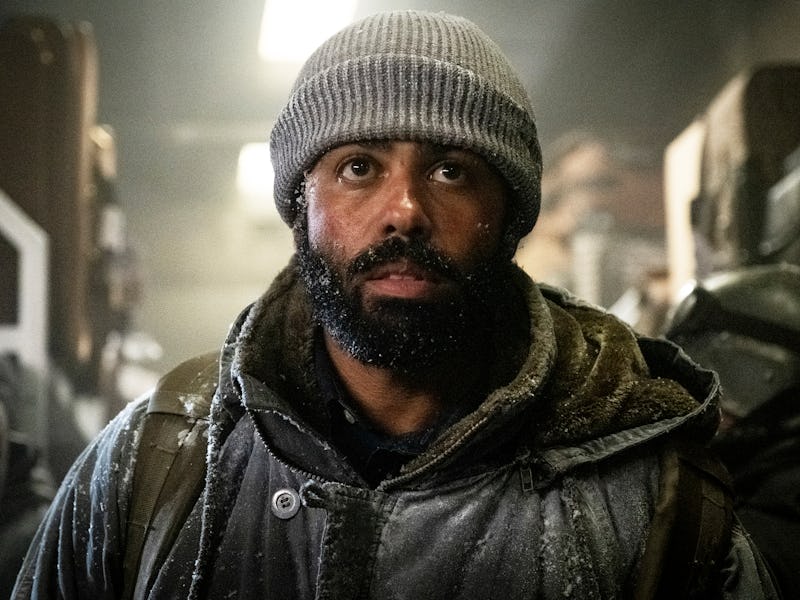TNT's Snowpiercer show is better than the movie, except for one big problem
TNT's new Snowpiercer adaptation of the French graphic novel than inspired Bong Joon-ho's film goes deeper into this post-apocalypse than ever before.

Before Snowpiercer, there was Le Transperceneige, a French graphic novel published in 1982 about a one-thousand-and-one-cars-long train carrying the last remnants of humanity through a frozen post-apocalypse. The 110-page story used this groundbreaking premise to tell a noir thriller that ends with the tail section getting detached from the rest of the train and everyone else dying from a pandemic. It wasn’t exactly an uplifting story.
Oscar-winning director Bong Joon-ho used this concept to create 2013’s Snowpiercer, streamlining Le Transperceneige into an explosive parable of class rage that forgoes the subtleties of the comic (a class of priest mechanics, new forms of sexual depravity, one thousand and one cars) to tell a story of the stark division between haves and have nots.
[We want to hear from you! Take this survey all about Emperor Palpatine and Star Wars.]
TNT’s new Snowpiercer show splits the difference, combining Bong’s exhilarating revolution with the extra breathing room that an entire TV season and one thousand and one cars has to offer.
One thousand and one cars isn’t just a cool number; it’s practically the show’s mantra. Each episode begins with a different character’s internal narration, ending with that same unimaginable number. It’s a clever reference to the original graphic novel, but also a way to ground TNT’s Snowpiercer even as the 10-episode season careens from its detective drama premise into a Bong-inspired class riot.
With all those episodes and train cars to play with, TNT’s Snowpiercer can do things Bong never could. We learn so much more about the oppressed lower class in the tail, the slightly-less-oppressed workers in third class (bustling markets and the best noodles on the train), the opulence of first-class passengers in the front (entire train cars occupied by single families and an actual bowling alley), and a sub-level with its internal transit system and an army of Brakemen cops and Jackboot soldiers. We learn how the train works, both as a feat of engineering and of social restructuring.
We also learn a lot more about Wilford, the inventor of Snowpiercer and the closest thing to a god this world has to offer. Bong Joon-ho came up with the idea for Wilford and cast Ed Harris in the role (in the original comic there’s just a humble engineer, a corrupt president, and the train itself, “Saint Loco”). Without spoiling a big, early reveal, I’ll just say that after watching Bong’s movie, you definitely won’t expect the version of Wilford in TNT’s Snowpiercer.
Jennifer Connelly and Daveed Diggs star in 'Snowpiercer'.
Snowpiercer begins with a mystery. There’s been a murder on the train, and the powers that be (Jennifer Connelly as Melanie Cavill, the head of hospitality) decide to pull Andre Layton (Daveed Diggs) out of the tail, offering the former homicide detective the opportunity to live in third class permanently if he can solve the mystery.
Eventually, Andre solves the case, revealing plenty of juicy hypocrisy in the process. It’s at this point the show takes a turn. (I’d argue for the worse, but you may think it’s for the better.) Instead of continuing on as a detective drama onboard Snowpiercer, it shifts into high gear, aping Bong’s story of revolution with a much more complicated revolution of its own. From this point out, the story is plenty of fun (if a little unbelievable at times) but fails to live up to its initial premise.
Diggs and Connelly have great chemistry that never fully gets explored. The rest of the acting is great, too. Steven Ogg (The Walking Dead) is a real standout as a tail passenger with compromised morals, Alison Wright shines as Connelly’s ruthless second-in-command, and Timothy V. Murphy is terrifying as the military leader Commander Grey who’s smarter than he looks. All these characters have roles to play in Snowpiercer’s revolution, but I’m more interested in learning about their day-to-day lives under some semblance of normal life.
Steven Ogg is a real standout as a tail passenger with compromised morals.
Snowpiercer suffers because of the era in which it was created. Despite being a weekly series on TNT, it’s constructed as one big story that people can binge once it winds up on Netflix — or, more likely, HBO Max. Every episode ends on a cliffhanger, with the biggest one saved for the Season 1 finale in a bid to keep people interested until Season 2. (It’s already been renewed.)
If Snowpiercer was released 10 years ago, it would be a 22-episode season about a streetwise ex-cop and a tightly wound political leader solving mysteries on a steampunk train in the post-apocalypse. That’s the show I really want, but I guess Snowpiercer is pretty good, too.
Snowpiercer premieres May 17 on TNT.